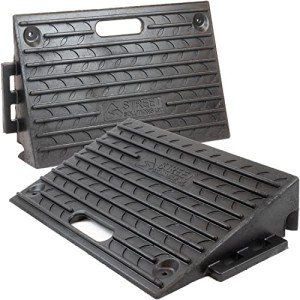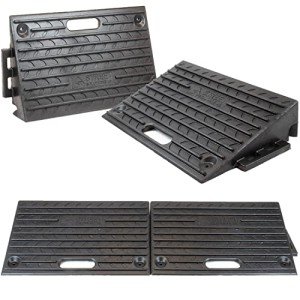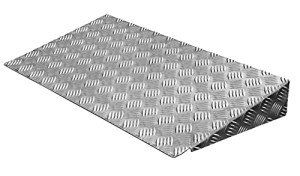In modern day living, accessibility is a common concern. Whether for loading and unloading heavy equipment, aiding people with mobility challenges, or providing safe transportation of goods, ramps have become essential in a variety of settings. Among the numerous options available, heavy-duty rubber ramps stand out for their durability, versatility, and ease of use. This guide discusses the benefits and features of a set of two heavy-duty 6” rubber ramps, providing insights into their use in both residential and commercial environments.
Understanding Heavy-Duty Rubber Ramps
Heavy-duty rubber ramps are designed primarily for stability and resilience. Made from high-quality, weather-resistant rubber, these ramps can bear substantial weight without deformation. The 6-inch height offers an ideal gradient for transitioning between different surfaces, minimizing strain for both users and their equipment.
Key Features
- Durable Material: Rubber construction provides a solid foundation that withstands wear and tear, making it ideal for both indoor and outdoor use.
- Non-Slip Surface: The textured surface prevents slipping, ensuring safety for people and vehicles transporting goods.
- Lightweight: Despite their heavy-duty design, these ramps are relatively lightweight, making them easy to move and store.
- Versatile Usage: Suitable for a range of applications, including residential homes, warehouses, garages, and outdoor events.
- Easy Installation: No assembly is required, allowing for quick setup and immediate use.
Applications of Heavy-Duty Rubber Ramps
Heavy-duty rubber ramps serve a variety of purposes across different sectors. Below are some common applications:
Residential Use
- Home Accessibility: Ideal for residences with steps, helping individuals using wheelchairs, walkers, or strollers access homes easily.
- Garage Use: Perfect for loading and unloading heavy items without damaging vehicles or straining the user.
Commercial Use
- Warehouse Operations: Essential for safe transportation of goods on and off trucks, reducing risk of injury during loading tasks.
- Event Management: Useful for outdoor gatherings or festivals, providing a safe passageway for attendees and vendors.
Recreational Use
- Mobility Aid at Parks: Enhance accessibility at parks and recreational facilities, enabling everyone to enjoy outdoor spaces.
Manufacturing and Supply Chain
- Loading Docks: Perfectly suited for facilitating smoother operations during the transfer of goods in and out of manufacturing facilities or distribution centers.
Benefits of Using Heavy-Duty Rubber Ramps
Understanding the benefits of heavy-duty rubber ramps is crucial for making an informed purchasing decision. Here are some significant advantages:
- Increased Safety: The robust construction and non-slip surfaces minimize fall and injury risks.
- Cost-Effective: Their durability means less frequent replacements, leading to long-term savings.
- Portability: With their lightweight design, ramps can be easily transported and set up in various locations.
- Weather Resistant: Designed to endure the elements, they don’t degrade when exposed to sun, rain, or snow.
- Customizable: Ramps can be combined for different heights, offering customized solutions suited to particular needs.
Installation and Maintenance
While installing heavy-duty rubber ramps is straightforward, following some guidelines will ensure that they perform to their optimal potential:
Installation Steps
- Identify Location: Find a flat surface where the ramp will be installed.
- Position the Ramp: Ensure the ramp sits securely against the surface, with no gaps that could lead to instability.
- Test the Ramp: Before use, conduct a test to confirm its stability and effectiveness.
Maintenance Tips
- Regular Inspections: Check for wear and tear regularly, particularly after extreme weather conditions.
- Keep Clean: Remove debris and dirt buildup to maintain a clear and safe surface.
- Store Properly: When not in use, store ramps indoors to prolong their lifespan.
FAQs
Q1: What weight capacity do heavy-duty rubber ramps typically support?
A: Most heavy-duty rubber ramps can support weight capacities ranging from 600 to 1,200 pounds, depending on the model and manufacturer.
Q2: Are these ramps suitable for outdoor use?
A: Yes, heavy-duty rubber ramps are designed to withstand various outdoor conditions, such as rain and sun exposure.
Q3: Can I use rubber ramps for my vehicle?
A: Absolutely! Rubber ramps are perfect for loading vehicles and provide a safe way to load items into vans, trucks, or SUVs.
Q4: Are there different heights available for rubber ramps?
A: Yes, rubber ramps come in various heights (e.g., 2, 4, and 6 inches), making it easy to match the ramp to your specific needs.
Q5: How do I clean my rubber ramp?
A: Cleaning can be done using mild soap and water. A soft broom or damp cloth works well to remove debris or stains.
In summary, a set of two heavy-duty 6” rubber ramps represents a valuable investment for anyone seeking improved accessibility, safety, and convenience. From homes to warehouses and outdoor events, these ramps provide a sturdy solution that accommodates a variety of needs. By offering a balance of durability and ease of use, they support individuals and businesses in navigating barriers with confidence. Proper installation and maintenance will ensure these ramps serve effectively for years to come, making them an essential addition to any accessibility toolkit.







